
Distributed Autonomy is the 5IR principle that shifts decision-making from centralized control systems to networks of semi-autonomous and fully autonomous agents—whether machines, vehicles, facilities, or software processes. Instead of relying on a single orchestrator, distributed autonomy allows local nodes to sense, decide, and act independently, while still collaborating within a larger system. This enables scalability, resilience, and efficiency across critical infrastructures, industrial processes, and mobility networks.
Distributed autonomy is a cornerstone of the Fifth Industrial Revolution. With it, systems keep functioning even if one node fails or communications are disrupted. It enables fleets of robotaxis, humanoid labor swarms, self-healing AI datacenters, resilient microgrids, and regenerative environmental systems. The future lies not in one central intelligence, but in millions of autonomous agents acting in unison, aligned by trusted frameworks and shared goals.
Decentralized Decision-Making
Local systems make context-aware decisions without waiting for central approval.
Example: Autonomous EV fleets rerouting around congestion; microgrid controllers balancing energy.
Swarm Intelligence
Collective behavior emerges from many agents following simple rules.
Example: emerges from many agents following simple rules.
Drone swarms for logistics, warehouse robots coordinating on the fly.
Edge Autonomy
AI models deployed at the edge allow real-time actions close to the data source.
Example: AI inference on EVs, robots, or industrial IoT nodes.
Hierarchical Autonomy
Multiple autonomy layers: device-level, facility-level, system-of-systems.
Example: Smart factory line robots ? plant EMS ? national energy grid.
Trust and Verification
Autonomy requires secure handshakes and auditability between agents.
Example: Blockchain-based ledgers, zero-trust networking, explainable AI models.
▢ Industrial Microgrids - Local controllers autonomously balance solar, wind, CHP, and BESS without grid dependency.
▢ Robotaxis & AV Fleets - Vehicles negotiate right-of-way and fleet charging without human dispatchers.
▢ Smart Factories - Autonomous robots reconfigure production lines based on supply chain shifts.
▢ Swarm Drones - Distributed UAVs surveil or defend perimeters collaboratively.
▢ Self-Healing AI Clusters - Server nodes reroute compute loads autonomously during failures.
▢ Coordination: Preventing agent conflicts, ensuring system-wide goals align.
▢ Safety: Avoiding unsafe emergent behavior.
▢ Cybersecurity: Distributed attack surfaces are harder to secure.
▢ Ethics & Accountability: Who is liable when autonomous agents make errors?
▢ Interoperability: Different vendors autonomous systems may not speak the same language.
▢ Consensus algorithms, supervisory AI.
▢ Testing, simulation, and certification frameworks.
▢ Zero-trust, encryption, AI-driven intrusion detection.
▢ Governance frameworks, auditable decision logs.
▢ Open standards, digital twin interoperability.